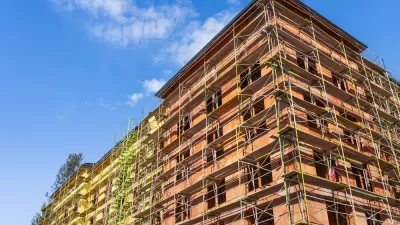The CodeNext project of updating the city of Austin's zoning code and land use policies has faced a controversial and protracted period of public scrutiny. The Allandale neighborhood provides a case study.
Catherine Marfin reports on potential changes to the zoning code in the Austin neighborhood of Allandale, as proposed by the draft of the CodeNext zoning code overhaul.
"Most of the existing regulations for the city’s residential neighborhoods were preserved in the initial draft of CodeNEXT, the overhaul of the Austin’s land use and zoning policies," writes Marfin. "Yet some communities, Allandale more than most, could see far more sweeping changes."
According to Marfin, Allandale is mostly a single-family neighborhood, "established in several phases from the late 1940s to the late 1960s" and "characterized by the post-World War II and midcentury single-family houses, the many original homeowners and the tree canopies lining the streets."
Under CodeNEXT, 80 percent of the neighborhood is zoned as a transect, and residents are concerned that designation strays too far from the single-family zoning currently in place. One building type that could potentially be developed in the neighborhood if it becomes a transect zone: cottage courts. Some residents, as represented by the Allandale Neighborhood Association, have collected their critiques of CodeNEXT into a position paper [pdf]. The question of whether the existing character of the neighborhood has been protected in line with expectation of these residents is obviously still up for debate.
FULL STORY: CodeNext draft proposes major changes for anxious Allandale community

Planetizen Federal Action Tracker
A weekly monitor of how Trump’s orders and actions are impacting planners and planning in America.

Maui's Vacation Rental Debate Turns Ugly
Verbal attacks, misinformation campaigns and fistfights plague a high-stakes debate to convert thousands of vacation rentals into long-term housing.

San Francisco Suspends Traffic Calming Amidst Record Deaths
Citing “a challenging fiscal landscape,” the city will cease the program on the heels of 42 traffic deaths, including 24 pedestrians.

Amtrak Rolls Out New Orleans to Alabama “Mardi Gras” Train
The new service will operate morning and evening departures between Mobile and New Orleans.

The Subversive Car-Free Guide to Trump's Great American Road Trip
Car-free ways to access Chicagoland’s best tourist attractions.

San Antonio and Austin are Fusing Into one Massive Megaregion
The region spanning the two central Texas cities is growing fast, posing challenges for local infrastructure and water supplies.
Urban Design for Planners 1: Software Tools
This six-course series explores essential urban design concepts using open source software and equips planners with the tools they need to participate fully in the urban design process.
Planning for Universal Design
Learn the tools for implementing Universal Design in planning regulations.
Heyer Gruel & Associates PA
JM Goldson LLC
Custer County Colorado
City of Camden Redevelopment Agency
City of Astoria
Transportation Research & Education Center (TREC) at Portland State University
Jefferson Parish Government
Camden Redevelopment Agency
City of Claremont





























